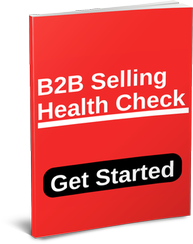 Imagine if a potential new customer asks you to come in and present your product or service. The prospect has already identified the problem they want to fix, defined the solution they are looking for, done their research and is now evaluating suppliers.
Imagine if a potential new customer asks you to come in and present your product or service. The prospect has already identified the problem they want to fix, defined the solution they are looking for, done their research and is now evaluating suppliers.
This scenario is actually quite common – customers increasingly only want to engage with their current (and potentially new) suppliers when they have defined the solution they want to buy.
My experience shows that many customers who are at this advanced stage in their buying process are asking for the wrong solution. The objective of your first meeting is then not to uncover needs (they have already done that by themselves) or to present your solution but to help them redefine the solution they are looking for based on what they really need.
This is exactly the situation I faced recently when I was contacted by the Managing Director of a Software Engineering company looking for a sales training program for their business unit leaders and account managers. Approximately 1 hour had been planned for the meeting and the MD started by explaining that their consultants had excellent technical expertise but lacked the business development skills required to identify and win new business. He had a fairly clear definition of the solution he was looking for. But as I listened to his introduction, I honestly felt that an alternative solution would be far more beneficial for the company.
Here are some questions you can ask in this scenario and the reasoning behind them.
1. What business objectives are you seeking to achieve with this programme?
The answer to this question gives you the bigger picture. If there's no real problem the prospect is trying to solve, there's no real reason for them to buy. In the conversation with the MD of the Software Engineering company, the answer was “to continue achieving an annual revenue growth of 20%”. He added that this percentage had not been achieved last year and that the outlook for this year wasn’t that bright.
2. What prompted you to do something about this now?
Prospects who have recently experienced a significant trigger event, such as a market shift, new competitors, or a major company development, will be motivated to address the issue now rather than later. The MD’s answer to this question was “our traditional business is being commoditized by professional buyers and low cost freelancers. We have to shift from selling expertise to selling solutions and this requires a different sales approach”.
3. Could you please walk me through an example to help me better understand exactly what you want to improve?
I often use this question to get the customer talking about the problem which needs to be fixed. It expands the perception of the problem in the customer’s mind and increases their desire to resolve it. Another question to gauge the urgency of the problem is “What happens if you do nothing about the problem?” If the answer doesn’t convince you, then it might be better to disqualify the lead or highlight to the customer the danger that lies ahead if the problem goes unresolved.
What comes next?
You are now most probably 20 minutes into the meeting. At this stage in the conversation you might want to summarize the customer’s objectives as well as the problems which need to be fixed. In the case of the Software Engineering company, the objectives were to continue growing by 20% per year, improve profitability by increasing daily rates and accelerate the shift from selling expertise to selling solutions. We will come back to these objectives later when we talk about developing a business case to quantify the benefits.
Now is the time to introduce the ideal solution. Each part of the solution – particularly the parts which are different from what the customer originally envisaged – have to be linked closely to achieving the agreed project objectives. You should substantiate your solution with a case study showing a satisfied customer who had similar objectives to your prospect. At the Software Engineering company the solution I proposed included a design phase to tailor the content to their business, a leadership enablement program, sales training for the target audience as well as implementation support and certification 6 months later of each leaders implementation. Remember the original solution they were asking for was only for sales training.
I suggest that you summarize this part of the meeting with the question: Based on what you've seen so far, do you think our solution would be a good approach to achieve your objectives?
Quantifying the benefits
You are now most probably 40 minutes into a 1 hour meeting. The agreed ideal solution is likely to cost more than the one the customer had in mind. So it’s important to ask if a budget is allocated to the project. The specific number doesn't matter as much as the fact that your price and the prospect's ability to pay are within the same ballpark. For instance, if your product costs €1 million and the prospect can only afford €100,000, the sale isn't going to go through.
The greater the gap between the customer’s budget and the likely cost of your solution, the more important the quantification of the benefits of your solution becomes. In the meeting with the MD of the Software Engineering company, I initiated this part of the conversation with the question: What does the success of this project look like to you, both in terms of qualitative and quantitative results? Depending on the type of relationship you have established you could also ask the question: What does solving this problem mean to you personally? What do you stand to gain if the issue was solved? What do you stand to lose if it goes unresolved?
Agreement to the next steps
Don’t forget to ask important qualification questions before moving forward:
-
How would the decision process work with an offering like this?
-
What would be your role in the process, and the roles of others on the decision team?
-
How does the budget sign-off process work?
-
What other solutions are you evaluating?
-
What hurdles could pop up and derail this project?
Then propose a next step, for example, agreeing a day and time to discuss your meeting summary or meeting other stakeholders involved in the decision to understand their needs. In the meeting with the MD of the Software Engineering company, the agreed next step was phase 1 of the project – which shows that challenging the customer’s definition of a solution really can work!
Questions to ask yourself
-
When in their buying process do your customers want to speak to you?
-
Is offering what the customer wants a good approach?
-
How do you move the customer from what they want to what they need?
Score yourself against 20 Success Factors with our B2B Selling Health Check:

